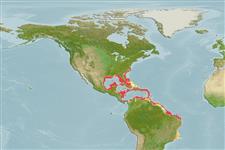Environment: milieu / climate zone / depth range / distribution range
Écologie
marin démersal; profondeur 35 - 365 m (Ref. 5222), usually 35 - ? m (Ref. 40849). Subtropical; 35°N - 22°S, 98°W - 35°W (Ref. 5222)
Western Atlantic: off North Carolina (pelagic post-larva, possibly drifted north from Florida or the Bahamas) to the Gulf of Mexico, Caribbean, and south to Vitoria, Brazil.
Taille / Poids / Âge
Maturity: Lm ? range ? - ? cm
Max length : 30.0 cm TL mâle / non sexé; (Ref. 7251)
Épines dorsales (Total): 8; Rayons mous dorsaux (Total): 13; Épines anales 3; Rayons mous anaux: 7. Distinguished by the following characteristics: head, body, dorsal and caudal fins yellow; 6-7 salmon-colored stripes from the head to the soft dorsal and caudal fins; blood-red blotch on the front half of anal fin; white blotch on the side of belly; pinkish purple pelvic fins; depth of body subequal to head length, depth contained 2.3-2.5 times in SL; width of body 2.3-2.4 times in body depth; head length 2.2-2.3 times in SL; convex interorbital area, convex dorsal head profile; rounded preopercle, with large, curved spine at angle, lower edge fleshy; very large middle opercle spine, extending to or beyond rear edge of opercular membrane; small posterior and anterior nostrils, subequal; well-developed supramaxilla and prominent bony knob (hidden by upper lip) on lower rear corner; short, curved, fixed canine tooth on each side of symphysis of both jaws and midside of lower jaw with 1-3 similar fixed canines (Ref. 89707).
A solitary species (Ref. 26340) inhabiting sandy bottoms and reefs (Ref. 89707). A beautiful and hardy species in the aquarium, prefers cooler waters and not good community dwellers for they are active piscivores (FB user, 27/04/12 ).
Life cycle and mating behavior
Maturité | Reproduction | Frai | Œufs | Fécondité | Larves
Heemstra, P.C. and J.E. Randall, 1993. FAO Species Catalogue. Vol. 16. Groupers of the world (family Serranidae, subfamily Epinephelinae). An annotated and illustrated catalogue of the grouper, rockcod, hind, coral grouper and lyretail species known to date. Rome: FAO. FAO Fish. Synop. 125(16):382 p. (Ref. 5222)
Statut dans la liste rouge de l'IUCN (Ref. 130435)
Menace pour l'homme
Harmless
Utilisations par l'homme
Pêcheries: intérêt commercial mineur; Aquarium: potentiel
Plus d'informations
Noms communsSynonymesMétabolismePrédateursÉcotoxicologieReproductionMaturitéFraiRassemblement de ponteFéconditéŒufsDéveloppement de l'œuf
RéférencesAquacultureProfil d'aquacultureSouchesGénétiqueElectrophoresesHéritabilitéPathologiesTraitementNutrientsMass conversion
CollaborateursImagesStamps, Coins Misc.SonsCiguateraVitesseType de nageSurface branchialeOtolithesCerveauxVision
Outils
Articles particuliers
Télécharger en XML
Sources Internet
Estimates based on models
Preferred temperature (Ref.
123201): 17.7 - 27.2, mean 23.9 °C (based on 222 cells).
Phylogenetic diversity index (Ref.
82804): PD
50 = 1.0000 [Uniqueness, from 0.5 = low to 2.0 = high].
Bayesian length-weight: a=0.01148 (0.00558 - 0.02364), b=3.04 (2.88 - 3.20), in cm total length, based on LWR estimates for this (Sub)family-body shape (Ref.
93245).
Niveau trophique (Ref.
69278): 3.8 ±0.5 se; based on size and trophs of closest relatives
Résilience (Ref.
120179): Milieu, temps minimum de doublement de population : 1,4 à 4,4 années (Preliminary K or Fecundity.).
Fishing Vulnerability (Ref.
59153): Low vulnerability (20 of 100).
